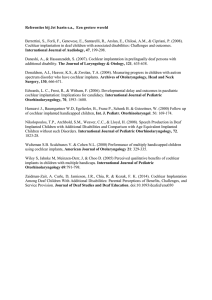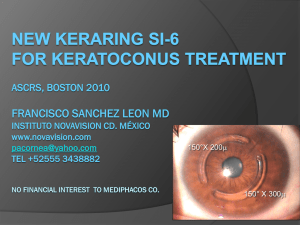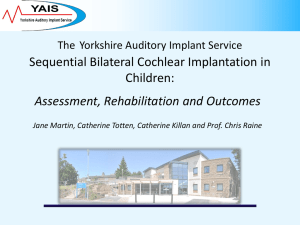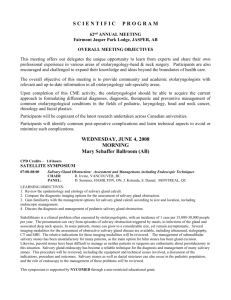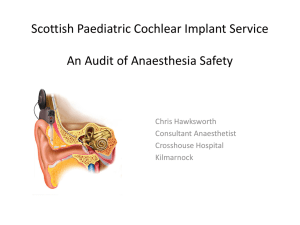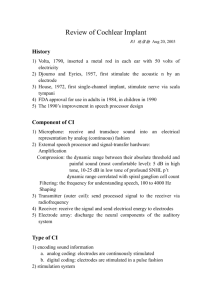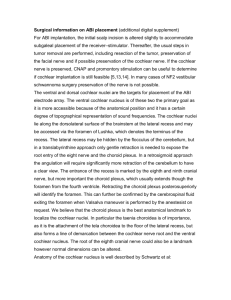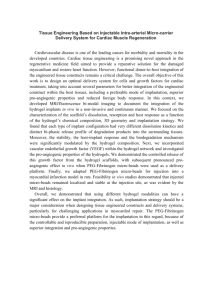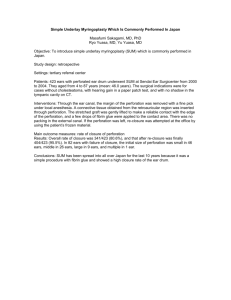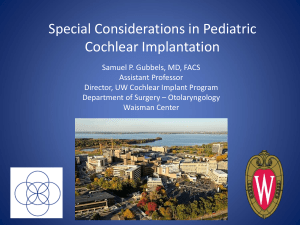Surgical Management of Cochlear Implants in Very Young Children
advertisement
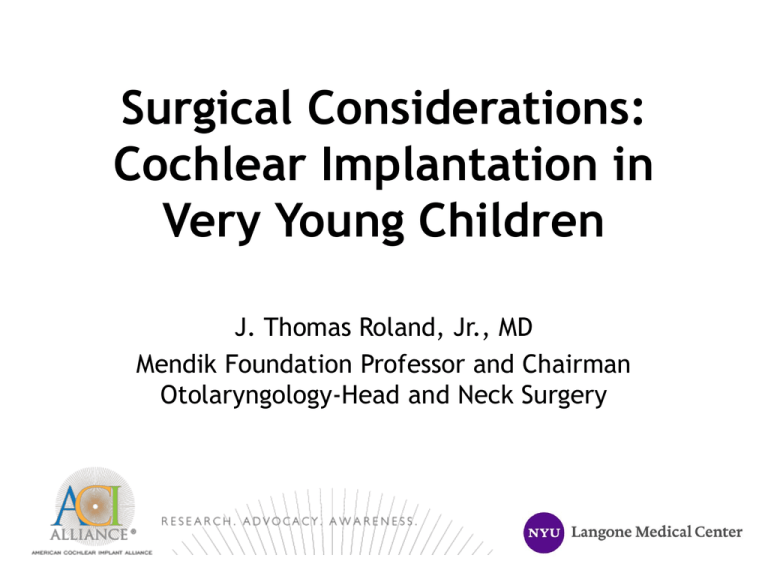
Surgical Considerations: Cochlear Implantation in Very Young Children J. Thomas Roland, Jr., MD Mendik Foundation Professor and Chairman Otolaryngology-Head and Neck Surgery Inspired by Parental Desire IT-MAIS 120 100 80 Normal hearing 6m post-ci, n=18 12m post-ci, n=9 60 40 20 Pediatrics 2006 6m 7. 5m 10 m 13 m 17 m 26 m 3m 4. 5m 1m 2m 0 Implanting Under One • Candidacy issues – Certainty of testing and deafness – Genetic evaluation • Programming issues – Objective programming • Anesthetic Risks • Surgical Risks – – – – – – Blood volume concerns Infectious risks Scalp flap issues Device migration Skull shape and thickness Facial nerve issues Anesthetic Risks • Pulmonary issues and cardiac reflexes to volume changes and anesthetics normalize around 6 months • Risks are greatly reduced when a pediatric anesthesiologist is present Blood Volume • Very young children do not have normal cardiac reflexes related to blood loss • Can lose 10% of volume without significant consequences • Ave. 11 lb (5kg) child has 350 cc volume • Mastoids are not fully pneumatized, mastoid emissary veins – Use diamond burrs for parts of mastoid – Careful on periostial elevation in pocket and behind mastoid Infectious Risks • Young children in general are at a higher risk of meningitis • The presence of a CI increases risks of meningitis • Kids with cochlear anomalies are at a higher risk of meningitis • Traumatizing the cochlear increases meningitis risks • Implanting earlier during the early otitis media prone years may increase the risk as well • Bilateral ? Doubling the risk Minimize Infectious Risks • Immunizations are important (prevnar 13, pneumovacs 23*) • Treat OM early and aggressively, communication with pediatricians • Use of tympanostomy tubes is safe • Minimal trauma to cochlea • Effective atraumatic electrode design and placement technique • Peri-operative antibiotics Scalp Flap and Fixation • Drill large well and depress the device with permanent fixation (this is controversial) – Minimizes migration – Lowers profile and tension on thin scalp • Concerns re: “tight pocket” concept • Migration of R/S Skull Growth Issues • Migration of plates and closure of skull sutures Skull Growth Issues • Cortex to Cochlea distance increases at more rapid rate 6 months 48 months Extrusions • Will we see more electrode extrusions? – Electrode fixation techniques – Coiling electrodes grasp cochlea • Consider extrusion when programming issues arise • Intra-operative baseline x-ray Skull Shape Issues • Placement usually more vertical in young children – Avoids coil on back of head Facial Nerve • Positioned close to surface until mastoid tip develops • Closer to surface within mastoid (1.0-1.5 cm) Facial Nerve • Use FN monitor • Watch incision inferiorly near tip • Avoid heating nerve when drilling through facial recess Summary • With appropriate precautions and attention to details, early implantation is safe • Fixation is important • Flap surveillance important • Attention to placement on skull • May need changes in device – Even better electrodes – Thinner Receiver/stimulators - smaller R/S – External hardware modifications to accommodate skull shape Cochlear Implantation in the very young child: long-term safety and efficacy Kevin H. Wang J. Thomas Roland, Jr., Maura Cosetti, Sara Immerman, Susan B. Waltzman NYU School of Medicine Laryngoscope 2010 comparison - complication rates 20% 18% 16% 14% 12% 10% Minor Major 8% 6% 4% 2% 0% Present Study (<12mo) N = 50 Ovesen (all ages) Bhatia (1-17yrs) summary • Complications for children <12mo. were minimal • No complications occurred after 10 months usage • Pts with complications had excellent long term outcomes review of literature: CI<12 mo 1st Author # Peri-op Complications James, AL 27 None Colletti, V 10 None Miyamoto, RT 13 None Waltzman, SB 18 None Dettman, SJ 19 None Miyamoto, RT 8 None Valencia, DM 15 One CSF leak conclusions • Cochlear implantation for children<12mo is safe and effective, both short-term and long-term • Careful and continued monitoring is necessary to minimize medical complications • 128 under one, 40% simultaneous bilateral Under One Evidence Safety and Efficacy • Coletti (2)- N=13 – Outcomes from several indices (Category of Auditory Performance, CAP; Peabody Picture Vocabulary Test (Revised), PPVT-R; Test of Reception of Grammar, TROG; and Speech Intellegibility Rating, SIR) in three groups of children with different ages at implantation (from 4 to 36 months) with a follow-up time from 4 to 9 years demonstrate that very early cochlear implantation (<11 months) provides normalization of audio-phonologic parameters with no complications. Safety and Efficacy • Schawers, et al (Belgium) – N=10 – The earlier the implantation took place, the smaller the delay was in comparison with normally hearing children with regard to the onset of prelexical babbling and with regard to auditory performance as measured by CAP. Safety and Efficacy • Dettman et al- N=19 • Results demonstrated that cochlear implantation may be performed safely in very young children with excellent language outcomes. The mean rates of receptive (1.12) and expressive (1.01) language growth for children receiving implants before the age of 12 mo were significantly greater than the rates achieved by children receiving implants between 12 and 24 mo, and matched growth rates achieved by normally hearing peers. These preliminary results support the provision of cochlear implants for children younger than 12 mo of age within experienced pediatric implantation centers. Safety and Efficacy • Lesinski-Schiedat, et al – N=29 • This study revealed that children implanted before the age of 1 year were subjected to no additional risks and showed superior development of speech understanding. Cochlear implantation should therefore be performed in very young children identified as suffering from profound bilateral hearing loss. No anesthetic or surgical complications. Safety and Efficacy • LOCHI Chin et al- N= 471 (41) – When measured at 6 and 12 months and 3 years of age after implantation, children who received CI prior to 12 months of age developed language within normal levels, on average Children who received CI after 12 months of age performed at 2 SD below the mean.
